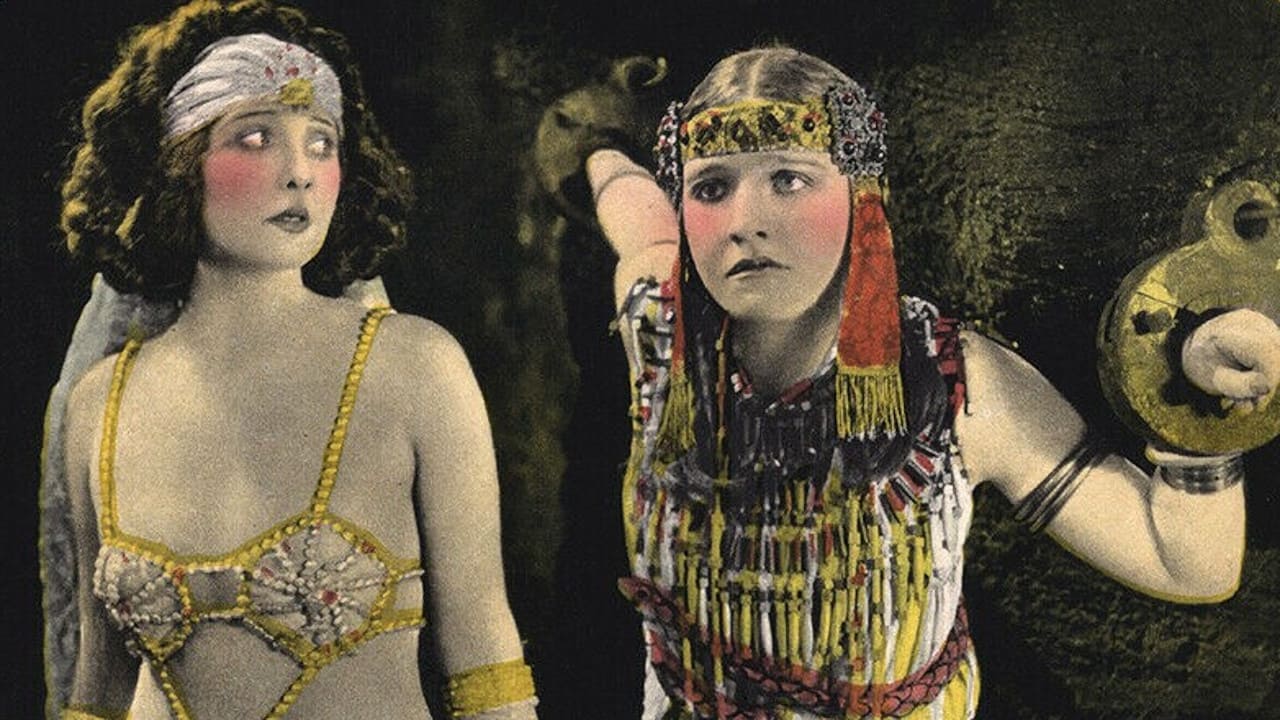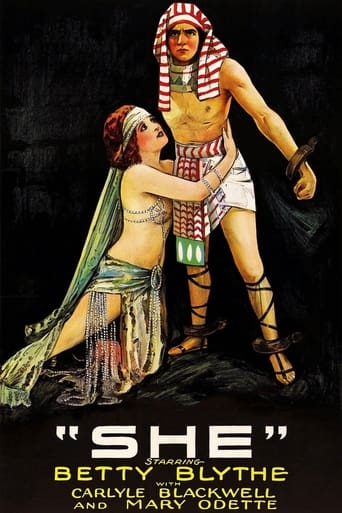



Most undeservingly overhyped movie of all time??
Load of rubbish!!
I didn’t really have many expectations going into the movie (good or bad), but I actually really enjoyed it. I really liked the characters and the banter between them.
View MoreThis is a dark and sometimes deeply uncomfortable drama
View MoreSilent screen siren Betty Blythe shot to stardom with "Queen of Sheba" (1921), where she joined "vamp" stars Theda Bara, Louise Glaum, and Pola Negri in popularity. That film, like this one, featured Ms. Blyth showing off her curvy figure in skimpy and see-through clothing. Although "Sheba" is presently a lost film, stills show Blythe's scanty costumes are as good as anything "She" wore here. This film is relatively well-produced, with fair effects, a hair-raising climax, and an important co-star in Carlyle Blackwell; while now forgotten, he was a very big name in early films.The frequently filmed H. Rider Haggard story begins with Mr. Blackwell (as Leo Vincy) discovering a relic that informs him about Blythe (as Ayesha, or "She-Who-Must-Be-Obeyed"), who loved his father (also essayed by Mr. Blackwell, in old age make-up) and (two thousand years of, presumably) others in the ancestral line. Blackwell accompanies pal Heinrich George (as Horace "The Baboon" Holly) and handyman Tom Reynolds (as Job) to Arabia. They meet up with native girl Mary Odette, flesh-eating cannibals (okay, maybe there aren't any other kind), and Blythe.****** She (1925) G.B. Samuelson ~ Betty Blythe, Carlyle Blackwell, Heinrich George, Mary Odette
View MoreThis is a good adaptation of Haggard's book, mostly because of Betty Blythe and the wardrobe department. Like everyone else, I assume, I saw the reedited American version, which exists in 16mm reduction prints. The film is choppy in a few places as a result, which are probably areas where footage was removed. I would guess that much of the footage removed was of the past story where She-Who-Must-Be-Obeyed killed the one she loved and probably some additional scenes of Carlyle Blackwell, who in the abridged version seems to be on screen less than is his sidekick stepfather. Originally, it was probably very faithful to Haggard's book because the author himself, apparently, had a role in the making of this adaptation shortly before he died, including credit for writing the title cards.Regardless, a good amount of time remains of Blythe, which is the most important thing. Blythe is not only beautiful and sexy, but also by far the best actor in this film. Additionally, her costumes are remarkably skimpy and sometimes transparent. Evidently, the filmmakers here used Blythe's role in "The Queen of Sheba" (1921) as a template. "The Queen of Sheba" is now one of the most coveted lost films, but it's clear from publicity stills that Blythe wore clothes (or lack thereof) with a similar purpose in both films, in addition to both pictures being semi-historical adventures with high production values and expensive sets. With "The Queen of Sheba", Blythe had established herself as the vamp heir apparent to Theda Bara at Fox, and she continued that path in this British production with another meaty anti-heroine, strong siren/vamp type of role. One of the best scenes in "She" uses lighting effects to make Blythe's face appear and disappear behind a veil when she first meets Heinrich George's character.The cave and mountain sets are more fantasy than realism due to their soft contours, which is probably appropriate. There are a good number of establishing shots to show them off, too, as well as some good lighting of them, which is somewhat difficult to detect from the 16mm source. Additionally, in this version, She's visions appear in a bath of water. The pillar of fire in the climax is clearly fabric, but I suspect that fact may have originally been concealed by hand-coloring of the print or something similar. It would be nice to see a more complete print, but what remains is good and entertaining.
View MoreThis movie only survives in its cut-down version. The is both an advantage for present viewers and a disadvantage. To deal with the latter first, there are a big gaps in continuity, making the story a little difficult to follow for those unacquainted with the novel. The advantages, however, are that with the elimination of the Ustane sub-plot, "She" herself now quickly becomes the center of attention, and deservedly so.The big question, however, is who plays Vincey (Leo's father) which is now a major role. This scene is directed in quite a different style from the rest of the movie, freely using close-ups of both George and the actor concerned. In the rest of the movie, George has only perhaps four close-ups all told. Tom Reynolds has one. The rest of the players including Blackwell, Blythe and Odette have none at all. (By close-up, I don't mean a shot in which the actor dominates or is photographed alone in the frame, but I mean an actual close-up of the face which fills the screen, TV-style). The actor playing Vincey has at least five or six close-ups in the opening scene, more than Heinrich George in fact, and he (not George) is the principal focus of attention. (George is usually ranked with Emil Jannings and Conrad Veidt as one of the top three German actors in silent films).I'm going to make a guess here. Maybe I'm wrong, but I think Carlyle Blackwell is playing the role. The director certainly goes out of his way to indulge him, and whoever it is, he puts the sick old man over with plenty of drama. A bit hammy, mind you, but effective nonetheless.In any case, forty-one-year-old Carlyle Blackwell (who played Bulldog Drummond in 1922 and Sherlock Holmes in 1929) is far too old for the hero, though photographer Blythe does his best to disguise the star's lack of youth (he's supposed to be twenty-five) by keeping his pancaked face (he seems to be wearing a wig) and portly figure (his clothes seem too tight) at a distance. Fortunately, in this version Mary Odette's role has been cut to the bone (a lovely girl indeed but she's an actress of the hair-pulling, eyes popping, mouth wobbling school), allowing us to enter into the presence of Betty Blythe without undue delay. She is by far the sexiest She in the cinema, and no mistake. Her costumes have to be seen to be believed.Although filmed on a lavish budget, the directors often muff their opportunities. True, there are some fantastic long shots to dazzle the eyes, but 99.9% of the time, the camera is bolted to the floor. The sets cry out for traveling shots to showcase their lavishness, but no such luck. As a general rule, long shots are ineffective on a TV screen, and here we have a couple of directors who are so fond of them, they put the camera at the end of the set all the time, as if they were presenting a stage play or a series of tableaux.This lack of basic directorial imagination makes the film seem static, old-fashioned, and lacking in movement. When Miss Blythe is not in sight, modern viewers will yawn and fidget and not be at all impressed by the richly decorated sets and often ingenious special effects. In fact most fans will prefer the 1935 or 1965 versions, even though these were filmed on far less extensive budgets from scripts Sir Henry Rider Haggard would definitely not approve. (Haggard gave his imprimatur to this version by writing the titles himself, a task he completed shortly before his death in 1925).
View MoreI have this film on Super-8mm, but with one or two reels missing, as mentioned above. Of course, the parts missing are important to the plot (primarily the face to face meeting with Leo and his dead ancestor). I think the production values are adequate for this kind of film, in the context of the time it was produced. My Blackhawk print is a little dark and contrasty, but it is enjoyable. I have watched it many times, but I would love to have a DVD copy of this film. (Perhaps I can make my own if none appears.) Perhaps someone out there would be so kind as to let me know whom to write to, in pursuit of this.Fortunately, I was able to show the picture at its proper speed, which helps give it weight and more lifelike movement. The portions of the film I do have look very good, so I am sure that someone out there could restore this and put it out on DVD.
View More